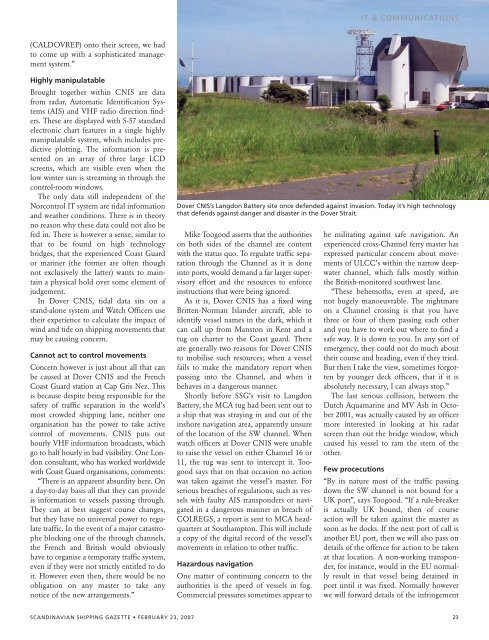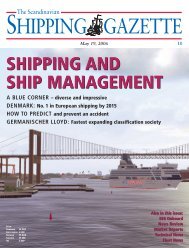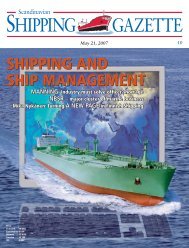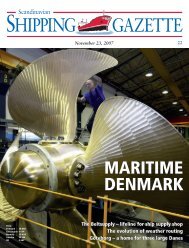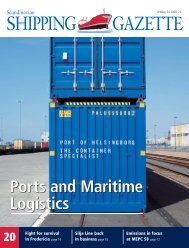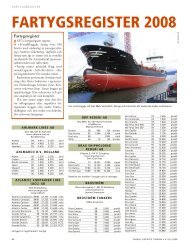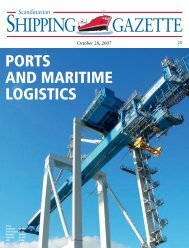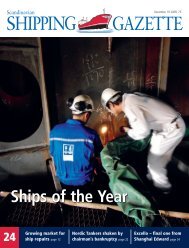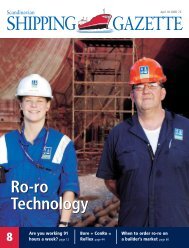SSG No 4 - Shipgaz
SSG No 4 - Shipgaz
SSG No 4 - Shipgaz
You also want an ePaper? Increase the reach of your titles
YUMPU automatically turns print PDFs into web optimized ePapers that Google loves.
(CALDOVREP) onto their screen, we had<br />
to come up with a sophisticated management<br />
system.”<br />
Highly manipulatable<br />
Brought together within CNIS are data<br />
from radar, Automatic Identification Systems<br />
(AIS) and VHF radio direction finders.<br />
These are displayed with S-57 standard<br />
electronic chart features in a single highly<br />
manipulatable system, which includes predictive<br />
plotting. The information is presented<br />
on an array of three large LCD<br />
screens, which are visible even when the<br />
low winter sun is streaming in through the<br />
control-room windows.<br />
The only data still independent of the<br />
<strong>No</strong>rcontrol IT system are tidal information<br />
and weather conditions. There is in theory<br />
no reason why these data could not also be<br />
fed in. There is however a sense, similar to<br />
that to be found on high technology<br />
bridges, that the experienced Coast Guard<br />
or mariner (the former are often though<br />
not exclusively the latter) wants to maintain<br />
a physical hold over some element of<br />
judgement.<br />
In Dover CNIS, tidal data sits on a<br />
stand-alone system and Watch Officers use<br />
their experience to calculate the impact of<br />
wind and tide on shipping movements that<br />
may be causing concern.<br />
Cannot act to control movements<br />
Concern however is just about all that can<br />
be caused at Dover CNIS and the French<br />
Coast Guard station at Cap Gris Nez. This<br />
is because despite being responsible for the<br />
safety of traffic separation in the world’s<br />
most crowded shipping lane, neither one<br />
organisation has the power to take active<br />
control of movements. CNIS puts out<br />
hourly VHF information broadcasts, which<br />
go to half hourly in bad visibility. One London<br />
consultant, who has worked worldwide<br />
with Coast Guard organisations, comments:<br />
“There is an apparent absurdity here. On<br />
a day-to-day basis all that they can provide<br />
is information to vessels passing through.<br />
They can at best suggest course changes,<br />
but they have no universal power to regulate<br />
traffic. In the event of a major catastrophe<br />
blocking one of the through channels,<br />
the French and British would obviously<br />
have to organise a temporary traffic system,<br />
even if they were not strictly entitled to do<br />
it. However even then, there would be no<br />
obligation on any master to take any<br />
notice of the new arrangements.”<br />
Mike Toogood asserts that the authorities<br />
on both sides of the channel are content<br />
with the status quo. To regulate traffic separation<br />
through the Channel as it is done<br />
into ports, would demand a far larger supervisory<br />
effort and the resources to enforce<br />
instructions that were being ignored.<br />
As it is, Dover CNIS has a fixed wing<br />
Britten-<strong>No</strong>rman Islander aircraft, able to<br />
identify vessel names in the dark, which it<br />
can call up from Manston in Kent and a<br />
tug on charter to the Coast guard. There<br />
are generally two reasons for Dover CNIS<br />
to mobilise such resources; when a vessel<br />
fails to make the mandatory report when<br />
passing into the Channel, and when it<br />
behaves in a dangerous manner.<br />
Shortly before <strong>SSG</strong>’s visit to Langdon<br />
Battery, the MCA tug had been sent out to<br />
a ship that was straying in and out of the<br />
inshore navigation area, apparently unsure<br />
of the location of the SW channel. When<br />
watch officers at Dover CNIS were unable<br />
to raise the vessel on either Channel 16 or<br />
11, the tug was sent to intercept it. Toogood<br />
says that on that occasion no action<br />
was taken against the vessel’s master. For<br />
serious breaches of regulations, such as vessels<br />
with faulty AIS transponders or navigated<br />
in a dangerous manner in breach of<br />
COLREGS, a report is sent to MCA headquarters<br />
at Southampton. This will include<br />
a copy of the digital record of the vessel’s<br />
movements in relation to other traffic.<br />
Hazardous navigation<br />
One matter of continuing concern to the<br />
authorities is the speed of vessels in fog.<br />
Commercial pressures sometimes appear to<br />
IT & COMMUNICATIONS<br />
Dover CNIS’s Langdon Battery site once defended against invasion. Today it’s high technology<br />
that defends against danger and disaster in the Dover Strait.<br />
be militating against safe navigation. An<br />
experienced cross-Channel ferry master has<br />
expressed particular concern about movements<br />
of ULCC’s within the narrow deepwater<br />
channel, which falls mostly within<br />
the British-monitored southwest lane.<br />
“These behemoths, even at speed, are<br />
not hugely manoeuvrable. The nightmare<br />
on a Channel crossing is that you have<br />
three or four of them passing each other<br />
and you have to work out where to find a<br />
safe way. It is down to you. In any sort of<br />
emergency, they could not do much about<br />
their course and heading, even if they tried.<br />
But then I take the view, sometimes forgotten<br />
by younger deck officers, that if it is<br />
absolutely necessary, I can always stop.”<br />
The last serious collision, between the<br />
Dutch Aquamarine and MV Ash in October<br />
2001, was actually caused by an officer<br />
more interested in looking at his radar<br />
screen than out the bridge window, which<br />
caused his vessel to ram the stern of the<br />
other.<br />
Few procecutions<br />
“By its nature most of the traffic passing<br />
down the SW channel is not bound for a<br />
UK port”, says Toogood. “If a rule-breaker<br />
is actually UK bound, then of course<br />
action will be taken against the master as<br />
soon as he docks. If the next port of call is<br />
another EU port, then we will also pass on<br />
details of the offence for action to be taken<br />
at that location. A non-working transponder,<br />
for instance, would in the EU normally<br />
result in that vessel being detained in<br />
port until it was fixed. <strong>No</strong>rmally however<br />
we will forward details of the infringement<br />
SCANDINAVIAN SHIPPING GAZETTE • FEBRUARY 23, 2007 23


